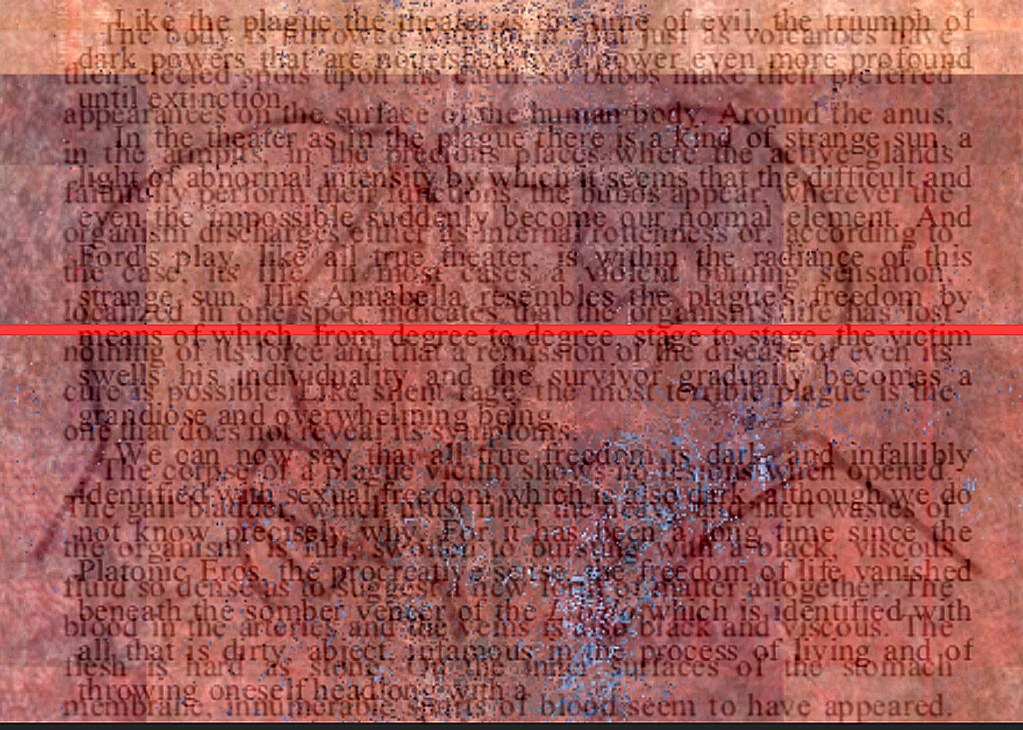TRANSMISSION ART ARCHIVE


Joseph Nechvatal
Joseph Nechvatal (born in Chicago in 1951) is an American post-conceptual artist currently living in Paris who creates virus-modeled artificial life computer-assisted paintings and digital animations. Themes he has addressed in his art include the apocalyptic, communication excess, the virus, and gender fluidity.
Nechvatal graduated Hinsdale Central High School in 1969. He then studied fine art and philosophy at Southern Illinois University at Carbondale (BFA 1973), and did masters work at Cornell University (1974) and Columbia University (1975). In 1975, Nechvatal moved to the downtown Tribeca area of New York City. He began studying at Columbia University with the philosopher Arthur Danto while working for the Dia Art Foundation as archivist to the minimalist composer La Monte Young.
In 1980, he moved from Tribeca to the sordid Lower East Side where he found artistic camaraderie and politically inspired creative energy. There he became closely associated with Collaborative Projects (Colab), the influential post-punk artists group that included Kiki Smith and Jenny Holzer, among others. Those were glory days for the famous Colab projects, such as Just Another Asshole, The Real Estate Show and The Times Square Show. He also helped establish the non-profit cultural space ABC No Rio, where exhibitions were animated by political purpose.
In the early 1980s, his art consisted of dense post-minimalist gray graphite drawings (that were sometimes photo-mechanically enlarged), of sculpture, of photographs, and of musique concrète audio collages.
In 1983, he co-founded the famous avant-garde art music project Tellus Audio Cassette Magazine. He chose the name Tellus from Tellus Mater: the ancient Roman earth-mother goddess of fecundity.
In 1984, he created an opera called XS: The Opera Opus (1984-6) with the no wave musical composer Rhys Chatham that was presented in Boston and in New York.
In 1986, Nechvatal began using computer-robotics to make conceptual paintings. Some were exhibited at Documenta VIII in 1987.
In 1992, when he was artist-in-residence at the Louis Pasteur Atelier in Arbois and at the Saline royale dArc-et-Senans, he created computer virus codes that he used as an artistic tool for his Computer Virus Project I. This work was a reflection on his personal experiences of risk and loss with the AIDS epidemic.
In 1995, at the urging of Pierre Restany, he moved to Paris and began splitting his time between Paris and New York.
In 1999, he earned his Ph.D. in the philosophy of aesthetics and technology in England and soon wrote two art theory books: Towards an Immersive Intelligence and Immersion Into Noise.
In 2002 he extended his experimentation into viral artificial life through a collaboration with the programmer Stephane Sikora in a work called the Computer Virus Project II, inspired by the a-life work of John Horton Conway (particularly Conways Game of Life), by the general cellular automata work of John von Neumann, by the genetic programming algorithms of John Koza, by the work of John Cage and Marcel Duchamp, and by the auto-destructive art of Gustav Metzger. These works include various series of computer-robotic assisted paintings, digital animations, and a lengthy audio composition entitled viral symphOny (2006-2008), among others audio works. Since, he has created a series of virus-based themed exhibitions of artificial life paintings and animation projections that explore the fragility and fluidity of the human body.
From 1999 to 2013, Nechvatal taught art theories of immersive virtual reality and the viractual (his term) at the School of Visual Arts in New York City (SVA). In 2014 he published (as editor) a book and CD/cassette tape with Punctum Books and Punctum Records on the noise music artist Minóy and in 2015 he published with Punctum Books a collection of his farcical erotic poetry entitled Destroyer of Naivetés. Nechvatal has regularly been publishing his art criticism and art book reviews at Hyperallergic, Whitehot Magazine of Contemporary Art, The Brooklyn Rail and Artforum.




